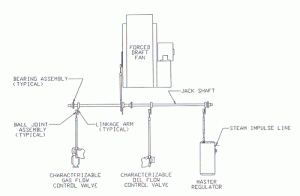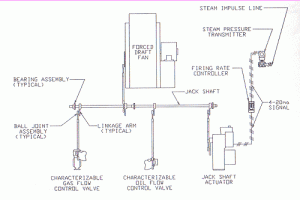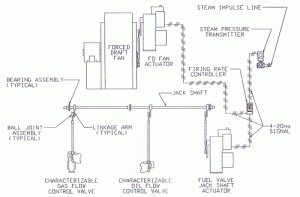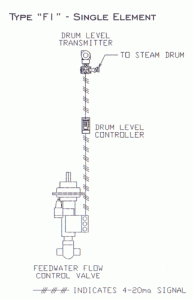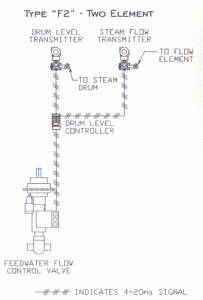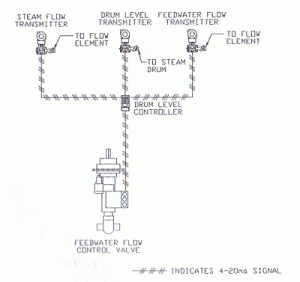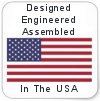Selecting the Best System for Your Applications
Single Point Positioning
Single point positioning systems are simple, highly reliable, and cost effective. A jack shaft is rotated by an actuator. The forced draft fan flow control damper and the fuel valves are mechanically linked to the jack shaft. The fuel valves are characterized, over the burner firing range, to achieve the proper fuel to air ratio. This system is ideal for burners with top-mounted forced draft fans that fire fuels with a relatively constant heating value. This system cannot be used on burners that fire two or more fuels simultaneously, or have a remote-mounted forced draft fan.
SPP-MR
The jack shaft actuator in this single point positioning system is a Hays Cleveland master regulator. The master regulator is a self-contained, fully automatic firing rate controller, combining the sensing element, response mechanism, and power actuator in one unit. A MANUAL-AUTO selector on the burner control panel allows switching from manual to automatic mode. In automatic mode, the jack shaft is regulated in direct proportion to the steam pressure demand signal.
SPP-PN or SPP-EC
The jack shaft actuator in this single point positioning system is a pneumatically (PN) or electrically (EC) powered actuator. A pressure transmitter measures the steam pressure. The firing rate controller receives the signal from the pressure transmitter. A MANUAL-AUTO button on the firing rate controller faceplate allows switching from manual to automatic mode. In automatic mode, the firing rate controller sends a signal to the jack shaft actuator to maintain the desired steam pressure set point.
Parallel Positioning
Parallel positioning systems use two actuators, one to position the fuel valve jack shaft, and one to position the FD fan damper. A pressure transmitter measures the steam pressure. The firing rate controller receives the signal from the steam pressure transmitter. The firing rate controller sends a signal to both the fuel valve jack shaft actuator and the forced draft fan damper to maintain the desired steam pressure set point. The characteristics of a parallel positioning system are essentially the same as the characteristics of a single point positioning system. Both systems rely on the position of the fuel and air flow devices to maintain proper fuel to air ratios. The fuel and air flow control devices in a parallel positioning system are linked “electronically”, as opposed to the mechanical linkage used in a single point positioning system. For this reason, fuel and air actuator feedback signals are used to ensure that the actuators “position” properly. The system automatically shuts down if the position error between the fuel and air actuators is too large. Parallel positioning systems cannot be used on burners that fire two or more fuels simultaneously.
PP
The Faber parallel positioning system consists of a fuel valve jack shaft, a fuel valve actuator, an air flow actuator, a firing rate controller, and a steam pressure transmitter.
Full Metering
Full metering systems continuously measure the fuel and air streams, adjusting the fuel and air control devices to maintain the desired fuel to air ratio. “Cross limiting” the fuel and air flow rates ensures that the air leads the fuel on load increases, and that the fuel leads the air on load decreases. This system will automatically shut down if the fuel-to-air ratio error becomes too large. Full metering systems can be used to fire two or more fuels simultaneously.
FM
The Faber full metering system consists of fuel and air flow elements and transmitters, fuel flow control valves, an air flow control actuator, fuel and air flow controllers, a steam pressure controller, and a steam pressure transmitter.
Oxygen Trim
An oxygen trim system increases the performance of any type of combustion control system by allowing more precise control of the fuel to air ratio. This results in increased boiler efficiency and lower operating costs. The oxygen trim system corrects for hysteresis in linkage type systems, slight changes in fuel heating value, and variations in the combustion air temperature. This system measures the excess oxygen in the flue gas and corrects the combustion air flow rate to maintain the proper excess air level.
01
If Faber type “PP” combustion controls are selected, the following equipment will be supplied: Oxygen analyzer with display and probe assembly (shipped loose for field mounting and installation), and an oxygen trim controller.
01
If Faber type “FM” combustion controls are selected, the following equipment will be supplied: Oxygen analyzer with display and probe assembly and a second loop will be added to the air controller for oxygen trim control.
Feedwater Control
F1
Single element feedwater control, includes a feedwater controller and a drum level transmitter (shipped loose for field installation).
F2
Two element feedwater control, includes a feedwater controller and the following items will be shipped loose for field installation: a drum level transmitter, a steam flow transmitter, and a steam flow orifice.
F3
Three element feedwater control, includes a feedwater controller and the following items will be shipped loose for field installation: a drum level transmitter, a feedwater flow transmitter, a feedwater flow orifice, a steam flow transmitter and a steam flow orifice.



